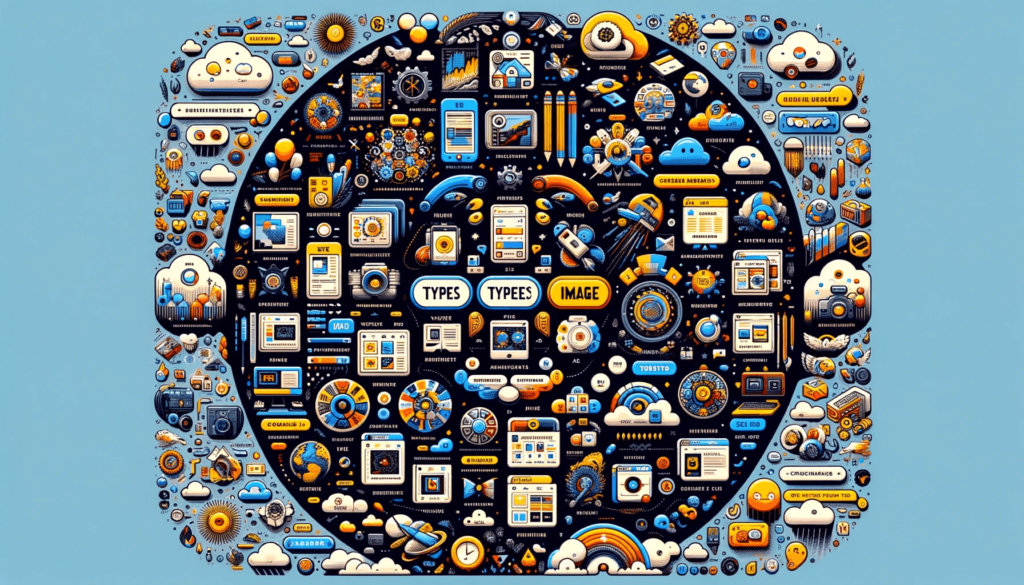
Did you know that there are multiple types of images, each with its own unique characteristics and uses? From high-quality TIFF files to compressed JPEGs and animated GIFs, the world of image formats is diverse and fascinating. In this article, I will explore the various types of images, their classifications, and their ideal use cases. So, let’s dive in and discover the wide range of image varieties available!
- There are 5 main formats in which to store images: TIFF, JPEG, GIF, PNG, and raw image files.
- Each format has its own characteristics, advantages, and ideal use cases.
- TIFF offers flexibility in color and content but creates large file sizes.
- JPEG is popular for digital photographs due to its compression and smaller file sizes.
- GIF is commonly used for animations and limited-color graphics on the web.
- PNG is preferred for web graphics with text, as it supports transparency and better compression.
- Raw image files contain a vast amount of data and are usually converted to TIFF for editing and color correction.
Contents
Key Takeaways:
- There are 5 main image formats: TIFF, JPEG, GIF, PNG, and raw image files.
- Each format has specific characteristics and use cases.
- TIFF offers flexibility but creates large file sizes.
- JPEG is popular for digital photographs.
- GIF is commonly used for animations and limited-color graphics.
Different image file formats for web use
When it comes to web use, there are several image file formats that you should consider. Each format has its own unique characteristics and advantages, making it suitable for different purposes on the web. Let’s explore the most commonly used image file formats for web use:
- JPEG (or JPG): JPEG is widely used for blog and article images on the web due to its good compression and reasonable file sizes. It is particularly suitable for photographs and images with complex color gradients.
- PNG: PNG is ideal for infographics, banners, and screenshots on the web. It maintains the detail and provides better text readability. Additionally, PNG supports transparency, making it a popular choice for web graphics.
- GIF: GIF is commonly used for animated images and quick-loading web graphics with limited colors. It is perfect for creating eye-catching animations and small file sizes.
- WebP: WebP is a newer image format that offers better compression and smaller file sizes compared to JPEG and PNG. It is specifically designed to optimize website loading speed, making it an excellent choice for improving web performance.
By understanding the characteristics and advantages of each image format, you can make informed decisions about which format to use for different types of content on your website.
Specialized image file formats and their uses
When it comes to image file formats, there are specialized options that cater to specific needs. Let’s explore some of these formats and the purposes they serve.
Tagged Image File Format (TIFF)
TIFF, or Tagged Image File Format, is commonly used in print publishing and photography due to its high quality and lossless compression. It is an excellent choice for preserving image details and ensuring optimal color accuracy. TIFF files can store multiple layers, making them ideal for editing and color correction processes.
Bitmap (BMP)
BMP, or Bitmap, is an outdated image format that is not practical for modern use cases. It results in large file sizes without offering any significant advantages over other formats. As a result, BMP is rarely used in current digital environments.
High Efficiency Image File Format (HEIF)
HEIF, or High Efficiency Image File Format, is a relatively newer format that offers high-quality images with efficient compression. While HEIF provides excellent storage efficiency, its support in browsers and operating systems is still limited. As a result, its usage is not as widespread as other formats at the moment.
Scalable Vector Graphics (SVG)
SVG, or Scalable Vector Graphics, is widely used for simple illustrations, shapes, and text. Unlike raster image formats like JPEG or PNG, SVG is based on mathematical equations and can be scaled to any size without losing quality. This format is particularly useful for web graphics and logos that need to be displayed at different sizes while maintaining sharpness and clarity.
In conclusion, specialized image file formats play a crucial role in various industries, catering to specific needs and requirements. Whether it’s the high quality and lossless compression of TIFF, the scalability of SVG, or the efficient compression of HEIF, understanding the uses and characteristics of these formats can help you make informed decisions for your image needs.
Fantasia Pix Conclusion
In conclusion, the world of image file formats is diverse and complex. Each format serves a specific purpose, whether it’s storing images for print, optimizing web graphics, or creating scalable vector illustrations. Understanding the characteristics and advantages of each format is crucial when making informed choices for your specific needs.
From the commonly used JPEG and PNG formats, which are ideal for digital photographs and web graphics, to specialized formats like TIFF for high-quality print publishing and SVG for scalable illustrations, there is a wide range of image file types to explore and utilize in your projects.
Remember, choosing the right image file format can significantly impact the quality, file size, and web performance of your visuals. Consider factors such as compression, color accuracy, transparency support, and scalability when selecting the most suitable format for your intended purpose.
By having a thorough understanding of the different image file formats and their applications, you can optimize your images for various scenarios and ensure that your visuals stand out and make a lasting impact.